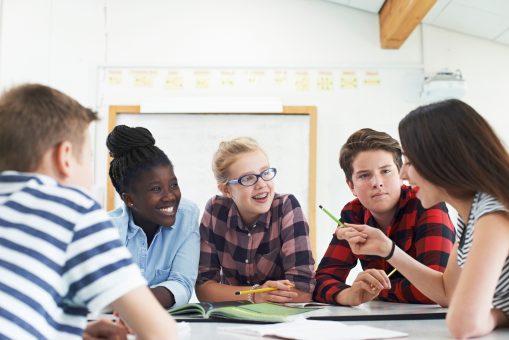
By Marion Goldstein, Ed.D., Originally published by SEL4NJ
Until recently, most school-based efforts around Social-Emotional Learning (SEL) were directed toward pre-school and the elementary grades. With anxiety, depression, and other signs of distress reaching crisis levels among older students, the urgent need for schools to promote SEL across all grade levels has become overwhelmingly clear.
Middle and high school teachers are expressing new levels of commitment to embrace the important role they can play in supporting students’ well-being, mental health, and learning. But although many SEL programs are out there for young children, the strategies that work for younger kids won’t go far with the teenage crowd. Adolescents aren’t just big children – their brains are growing and changing at a record-breaking pace, allowing them to think in more complex ways and to build skills they need to navigate challenges in school and everyday life. At the same time, their thinking is not the same as adults – it can be exaggerated, erratic, and a bit immature. For SEL to happen well, it’s important to attend to factors unique to adolescence that influence the ways in which teens think about, engage with, and develop social-emotional competencies.
Here are some things to keep in mind when integrating SEL in your work with middle or high school students.
The eyerolls come easily
When teachers (or any grown-ups) talk about things like personal development, relationships, and good behaviors, it’s almost like teens are waiting to sound the Preachy Alarm. Challenge their assumptions with fun activities, developed for their age group, that motivate them (not you!) to make genuine connections to their real lives. For example, they enjoy creating, not just reading, stories. Bring that opportunity into your curriculum!
Keep it brief
Many teens respond better to brief, focused, “micro-learning” experiences than to long lessons. And this isn’t just because their attention spans are sponsored by TikTok and Snapchat; it’s good for learning! Learning in bite-sized chunks increases comprehension, retentioni, and confidence in applying skillsii.
They’re newly wired for thinking about their thinking
The ability for reflection (looking back to process an experience) and for metacognition (reflection’s fancy cousin, which is thinking about your thinking), is thought to emerge in adolescenceiii. However, just because new thinking tools become available doesn’t mean students will use them well; the right circumstances must be in place. Developmentally-designed prompts presented in the context of authentic skill-building activities can motivate students to reflect independently and in groups. To build SEL, use reflective prompts to help students think about how to manage themselves and their emotions, be more self- and socially aware, make responsible decisions, and build meaningful relationships.
Actions speak louder than words
Teens are like most of us in that we learn more deeply by doing. Experiential learning motivates students to apply their knowledge with purpose and in ways that are real to them. There are infinite ways in which this can play out, and you probably do some in your teaching already. When it comes to SEL, here are just a few examples …
- To practice self-management during a stressful time, students develop their own priority list or study plans.
- To practice responsible decision-making, students think of an action they can take to benefit their community. Carry out plans over a week or more and share experiences.
- To develop social awareness, students identify ways they can show empathy at school. Generate and commit to an “empathy assignment” in which students practice empathy in ways they identified.
They want to run their own show
Teens do NOT like being told what to do – let’s face it, do any of us? In the classroom and beyond, they’re motivated and learn more deeply when they have freedom to navigate their own experiences. For example, you may try out a mix of digital, in-person, independent, small- or whole-group experiences. This helps make sure there’s something for everyone, while also giving students reasons to put their knowledge to work in different contexts. To make activities more self-directed, allow students to choose how they share their thinking, as some feel more comfortable writing their thoughts, whereas others thrive in one-on-one or group discussions. If you’re looking for ways teens can run the show outside of the classroom, consider offering a curated set of online SEL activities and inviting students to find ones that resonate most. Being able to access activities on a phone, tablet, or other mobile device reduces access barriers and can encourage students to seek out just-in-time support as situations arise. Homework assignments in which they do SEL activities of their choice also put teens in charge while helping you extend learning beyond the classroom.
They’re social beings … and all learning is social
Relationships are always important for learning, but as kids grow up their needs and priorities change. During the middle school years, teachers and parents typically become less influential and friends become more important for social support, well-being, belonging, and self-esteem.ivv Given this, it makes sense for students to be an integral part of efforts to support SEL in the classroom. Make students partners in setting classroom norms and collaborating to identify activities that build core life skills and set the stage for them to serve as long-term models and positive influences for each other.
SEL efforts also motivate students to connect meaningfully with teachers and family. Good SEL programs for adolescents are few and far between. Fortunately, these guidelines apply regardless of whether you’re using an established SEL curriculum, an approach developed in your school, or designing your own activities.

- Marion Goldstein, Ed.D., is Director of Strategic Partnerships at Vivensity. As a firm believer that schools must empower students to build skills for life by prioritizing social and emotional learning alongside academics, she draws on extensive expertise in the development, implementation, scale-up, and evaluation of educational innovations. In doing so, she applies the learning sciences through product and program management, co-design, research, and collaborative partnerships to ensure technology empowers and unleashes teaching and learning opportunities for all. Dr. Goldstein is a widely published author and presenter to diverse audiences. Connect with her on LinkedIn here.
